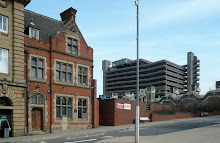Image: Joe Clark, The Blue of the Distance 2012, Steel frame, Bike Components, 2 x Slide Projectors. 2012, Dimensions Variable. 120 x 190 x 300cm. Installation View Higher Atlas Marrakech Biennale 2012. Courtesy of the artist and Workplace Gallery, UK.
Joe Clark
Screentest (For a Hero Shot)
Preview: Friday 22nd June 2012 , 6 - 9pm
Exhibition continues:
23rd June - 28th July 2012
Tuesday - Saturday, 11am - 5pm
(or by appointment)
Workplace Gallery are pleased to announce Screentest (for a hero shot) our first solo exhibition by Joe Clark.
Clark's new work investigates the unstable truths of the contemporary image through an appropriation of production methods used in commercial photography. Finding historical parallels in the strategies of Early Cubism, Clark explores this radical avant-garde abstraction of the pictorial image within the context of a consumer driven digital culture.
Clark's immersive installation The Blue of the Distance is a mechanical stereo machine based around the effect achieved by crude 2-frame stereo GIF animations, and the working practices of early photo-chemical photographers who were sent out to record natural phenomena in stereo for the enjoyment of metropolitan audiences in Europe. Originally made for this year's Marrakech Biennale the work depicts an unspecified and generic peak in the atlas mountain range which lies to the south of the city. Two 35mm colour slides of the snow capped peak taken approximately 200m apart from an opposing ridge are projected from a steel structure that houses a lo-fi mechanism converted from salvaged bicycle components allowing the viewer to manually operate the machine. The Blue of the Distance explores the seductive promise of images and their ultimate failure to transport us anywhere.
The C-Type series Asset Management made during a recent residency in Brazil alludes to the reduction of place and space to digital 'assets', which are then utilised in a photographic workflow towards the goal of a tightly calibrated photographic image. Using an image that contains the full 360° view of a scene from a fixed perspective an 'environment' is created that a simulated object may be placed inside. By rendering the model from the point of view of a virtual camera, the model can receive lighting information and accurate reflections, making it appear to be 'there'.
"In this series I'm utilising and disrupting reflections by 'drawing' in space with mirrored polygons. The language of these drawings is somewhat expressive and opaque- attempting an articulation of an intuitive and perhaps more traditional mode of artistic expression within a technical apparatus."
Joe Clark 2012
In an antonymous relationship to the Asset Management series Clark further explores the correlation between photography and an analytical consideration of Drawing through a series of minimal black and white photographs of planar objects constructed specifically for the single point perspective of the fixed studio camera. Through the photograph, the spatial information of the architectonic object is flattened into the 2-Dimensional picture plane: the edges of the object become linear compositional devices and the surface is simplified towards basic tonal grades. This effect is compounded by the making of the object to be purposefully reduced to 2-Dimensions, flatness is intrinsic to its design and it's 3-Dimensionality serves only to explore tone and line in a compositional sense. Made from differing grades of polystyrene these works eschew traditional material hierarchies to further distance themselves from the 'real'.
In a world where digital image manipulation post-Photoshop has become de-rigueur and the distance between the professional photographer and amateur has narrowed significantly, Clark's works question how images are both made and received. His analytical deconstruction either through an explicit foregrounding of an apparatus that is present in the space, or through markers left within in the images allow the method of production to be traced and understood. The tension that arises is between this explication and the image itself.
Joe Clark was born in 1982 in RAF Wegberg, B.A.O.R. Recent exhibitions include: Higher Atlas, Marrakech Biennale; New Contemporaries 2010 - ICA London and A-Foundation, Liverpool; Re:Animate, Oriel Mostyn, Wales. In 2012 Clark was artist in residence at Fundação Armando Alvares Penteado, Sao Paulo, Brazil, he studied in Northumbria University, Newcastle and The Slade School of Art, London. Clark lives and works in London, UK.
Workplace Gallery was founded in 2005 by artists Paul Moss and Miles Thurlow. Based in Gateshead UK, Workplace Gallery represents a portfolio of emerging and established artists through the gallery programme, curatorial projects and international art fairs. Workplace Gallery is currently located in The Old Post Office, Gateshead; a listed 19th Century red brick building built upon the site where the important British artist, engraver and naturalist Thomas Bewick (1753-1828) lived and died.
Kindly supported by








